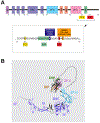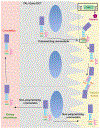Evolving Concepts in Uromodulin Biology, Physiology, and Its Role in Disease: a Tale of Two Forms
- PMID: 35959659
- PMCID: PMC9669127
- DOI: 10.1161/HYPERTENSIONAHA.122.18567
Evolving Concepts in Uromodulin Biology, Physiology, and Its Role in Disease: a Tale of Two Forms
Abstract
Uromodulin (or Tamm-Horsfall protein) is a glycoprotein uniquely produced in the kidney by tubular cells of the thick ascending limb of the loop of Henle and early distal tubules. This protein exhibits bidirectional secretion in the urine and in the renal interstitium and circulation. The role of this protein in maintaining renal and systemic homeostasis is becoming increasingly appreciated. Furthermore, perturbations of its functions may play a role in various diseases affecting the kidney and distant organs. In this review, we will discuss important advances in understanding its biology, highlighting the recent discoveries of its secretion and differential precursor processing that generates 2 forms: (1) a highly polymerizing form that is apically excreted in the urine and generates filaments and (2) a nonpolymerizing form that retains a polymerization inhibitory pro-peptide and is released basolaterally in the kidney interstitium and circulation, but can also be found in the urine. We will also discuss factors regulating its production and release, taking into account its intricate physiology, and propose best practices to report its levels. We also discuss breaking advances in its role in hypertension, acute kidney injury and progression to chronic disease, immunomodulation and regulating renal and systemic oxidative stress. We anticipate that this work will be a great resource for researchers and clinicians. This review will highlight the importance of defining what regulates the 2 forms of uromodulin, so that modulation of uromodulin levels and function could become a novel tool in our therapeutic armamentarium against kidney disease.
Keywords: Tamm-Horsfall Protein; hypertension; kidney injury; renal physiology; uromodulin.
Conflict of interest statement
Conflicts of Interest:
The authors have a patent for using modified Uromodulin (Tamm-Horsfall protein) in therapeutic applications: Modified Tamm Horsfall protein and related compositions and methods of use-US11053290B2, and have another patent application for developing new regents to measure non-polymerizing Uromodulin.
Figures




Similar articles
-
Uromodulin biology.Nephrol Dial Transplant. 2024 Jun 28;39(7):1073-1087. doi: 10.1093/ndt/gfae008. Nephrol Dial Transplant. 2024. PMID: 38211973 Free PMC article. Review.
-
The kidney releases a nonpolymerizing form of uromodulin in the urine and circulation that retains the external hydrophobic patch domain.Am J Physiol Renal Physiol. 2022 Apr 1;322(4):F403-F418. doi: 10.1152/ajprenal.00322.2021. Epub 2022 Jan 31. Am J Physiol Renal Physiol. 2022. PMID: 35100812 Free PMC article.
-
Tamm-Horsfall Protein Regulates Mononuclear Phagocytes in the Kidney.J Am Soc Nephrol. 2018 Mar;29(3):841-856. doi: 10.1681/ASN.2017040409. Epub 2017 Nov 27. J Am Soc Nephrol. 2018. PMID: 29180395 Free PMC article.
-
Systemic Effects of Tamm-Horsfall Protein in Kidney Disease.Semin Nephrol. 2022 May;42(3):151277. doi: 10.1016/j.semnephrol.2022.10.003. Epub 2022 Nov 18. Semin Nephrol. 2022. PMID: 36411194 Review.
-
Uromodulin: Roles in Health and Disease.Annu Rev Physiol. 2021 Feb 10;83:477-501. doi: 10.1146/annurev-physiol-031620-092817. Annu Rev Physiol. 2021. PMID: 33566673 Review.
Cited by
-
Uromodulin biology.Nephrol Dial Transplant. 2024 Jun 28;39(7):1073-1087. doi: 10.1093/ndt/gfae008. Nephrol Dial Transplant. 2024. PMID: 38211973 Free PMC article. Review.
-
Case report: Renal adenoma in a captive ocelot (Leopardus pardalis) in Costa Rica.Front Vet Sci. 2024 May 2;11:1393039. doi: 10.3389/fvets.2024.1393039. eCollection 2024. Front Vet Sci. 2024. PMID: 38756505 Free PMC article.
-
Disrupted uromodulin trafficking is rescued by targeting TMED cargo receptors.J Clin Invest. 2024 Dec 16;134(24):e180347. doi: 10.1172/JCI180347. J Clin Invest. 2024. PMID: 39680459 Free PMC article.
-
Renal Assessment in Acute Cardiorenal Syndrome.Biomolecules. 2023 Jan 27;13(2):239. doi: 10.3390/biom13020239. Biomolecules. 2023. PMID: 36830608 Free PMC article. Review.
-
Anion exchange chromatographic fractionation of urinary proteins followed by tandem mass spectrometry identifies potential natural inhibitors of calcium oxalate stone.Comput Struct Biotechnol J. 2025 Jun 18;27:2688-2700. doi: 10.1016/j.csbj.2025.06.028. eCollection 2025. Comput Struct Biotechnol J. 2025. PMID: 40612498 Free PMC article.
References
-
- Tamm I, Horsfall FL Jr. Characterization and separation of an inhibitor of viral hemagglutination present in urine. Proc Soc Exp Biol Med. 1950;74:106–108. - PubMed
-
- Muchmore AV, Decker JM. Uromodulin. An immunosuppressive 85-kilodalton glycoprotein isolated from human pregnancy urine is a high affinity ligand for recombinant interleukin 1 alpha. J Biol Chem. 1986;261:13404–13407. - PubMed
-
- Dawnay AB, Cattell WR. Serum Tamm-Horsfall glycoprotein levels in health and in renal disease. Clin Nephrol. 1981;15:5–8. - PubMed
-
- Trudu M, Janas S, Lanzani C, Debaix H, Schaeffer C, Ikehata M, Citterio L, Demaretz S, Trevisani F, Ristagno G, et al. Common noncoding UMOD gene variants induce salt-sensitive hypertension and kidney damage by increasing uromodulin expression. Nat Med. 2013;19:1655–1660. doi: 10.1038/nm.3384 - DOI - PMC - PubMed
Publication types
MeSH terms
Substances
Grants and funding
LinkOut - more resources
Full Text Sources
Medical

